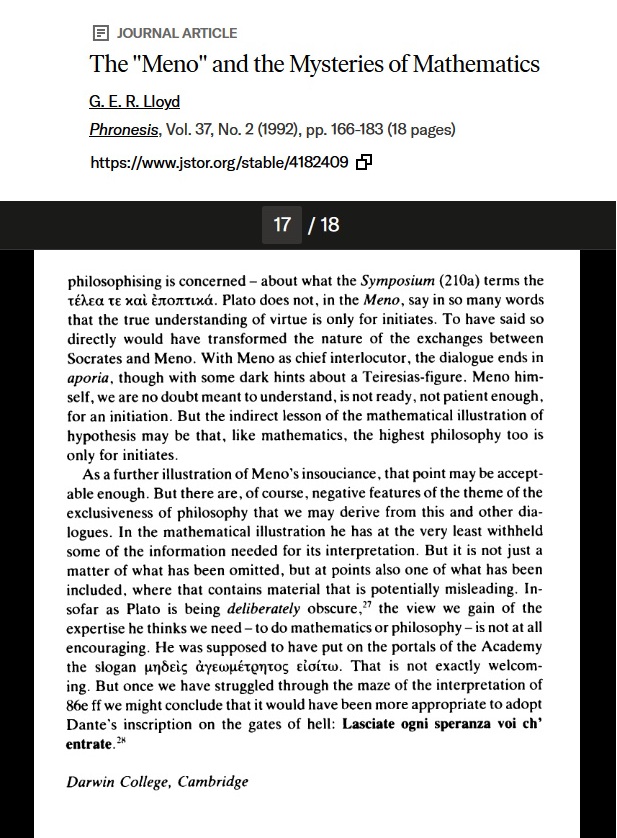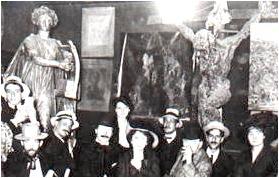The previous post suggests a review of two earlier images —
Sunday, July 20, 2025
Circle and Square: The Impossible Dream
Meno 86e for the Turkish Breakfast Club
Update of 12:36 PM EDT July 20, 2025 —
Could the second geometry problem in Plato's Meno illustrate
one tentative approach to the classical problem of squaring
the circle ?
If so, the following remarks seem relevant . . .

Tuesday, July 19, 2022
Two for the Undercroft
From The New York Times this afternoon —
Transylvania III, a 1973 tapestry made of horsehair and goat hair.
Backstory —

Tommy Tucker’s Song
The Lost Message
“Somehow, a message had been lost on me. Groups act .
The elements of a group do not have to just sit there,
abstract and implacable; they can do things, they can
‘produce changes.’ In particular, groups arise
naturally as the symmetries of a set with structure.”
— Thomas W. Tucker, review of Lyndon’s Groups and Geometry
in The American Mathematical Monthly , Vol. 94, No. 4
(April 1987), pp. 392-394.
"…groups are invariably best studied through their action on some structure…."
— R. T. Curtis, “Symmetric Generation of the Higman-Sims Group” in
Journal of Algebra 171 (1995), pp. 567-586.
Related material — Other posts now tagged Groups Act.
Monday, July 18, 2022
The Big Shuttlecock
"Oldenburg … died on Monday at his home and studio in
the Soho section of Manhattan." — Martha Schwendener, NYT
Sunday, May 2, 2021
Le Rouge et le Noir
The title, by Stendhal, is that of a novel which, according to Wikipedia,
“chronicles the attempts of a provincial young man to rise socially
beyond his modest upbringing through a combination of talent,
hard work, deception, and hypocrisy.”
Another chronicler of deception, the author of Red Sparrow ,
reportedly died on Wednesday, April 28.
Black Sparrow:
Monday, February 3, 2020
Notification
See as well a Steiner book cover in Art Space, a post of May 7, 2017.
Ereignis*
A sequel to Xmas Eve 2019 —
* "Ereignis appears in Heidegger's later works
and is not easily summarized." — Wikipedia
Tuesday, December 24, 2019
Stille Nacht

Later in the film… "He's not Einstein… You're Einstein."
Related material at the University of Iowa —
See as well this journal on the above Daily Iowan date.
Lucy Noir …
… Continued from August 26 —

Heidegger, "Hölderlin and the Essence of Poetry,"
translated by Douglas Scott, in Existence and Being ,
Regnery, 1949, pp. 291-316—

See as well Readings for St. Patrick's Day, March 17, 2005.
Monday, August 26, 2019
Monday, March 13, 2006
Monday March 13, 2006
| Le Républicain Lorrain du 14 janvier 2001
Le Lapin Agile veille sur la Butte (par Michel Genson) 24 décembre 1900. Dans son atelier glacial du Bateau Lavoir, à flanc de la colline de Montmartre, Picasso se frotte les yeux. C’est bien Wasley, son ami Wasley, qu’il aperçoit traversant la place Ravignan, courbé sous le poids d’un grand Christ en croix. Le sculpteur titube et s’en va gravissant un à un les escaliers qui mènent au sommet de la Butte, direction la rue des Saules. Car l’œuvre est destinée aux murs du petit estaminet où la bande a trouvé asile, pour y échanger chaque soir des refrains, bocks et vaticinations les plus folles. La bande, c’est à dire Utrillo, Max Jacob, Modigliani et les autres… Un siècle et un souffle de légende plus tard, le même Christ blanc occupe toujours la même place, sous les lumières tamisées du Lapin Agile. À l’abri sous son aisselle droite, l’autoportrait de Picasso en Arlequin a été authentique en son temps. Jusqu’au jour où le grand Frédé, tenancier mythique du lieu, s’est gratté la barbe avant de le céder à un amateur suédois de passage. Depuis l’original a fait le voyage du MAM (Modern Art Museum) de New-York, et la Butte se contente d’une copie. Pour le reste, rien a changé ou presque pour le doyen des cabarets parisiens. Ni le décor, ni l’esprit. L’incroyable patine noire des murs, posée là par des lustres de tabagies rigolardes ou inspirées, rappelle au générique les voix des habituées de jadis, Apollinaire, Carco, Dullin, Couté, puis Pierre Brasseur, et plus proches de nous encore d’autres débutants, Caussimon, Brassens, François Billetdoux… La liste exhaustive serait impossible à dresser de tous ceux qui ont émargé au livre d’or du Lapin Agile. Malgré les tempêtes et les modes, le Lapin Agile dure et perdure donc. Et sa silhouette pour carte postale inspire toujours les peintres venus de partout. Comme si la halte faisait partie d’un parcours initiatique immuable. Deux pièces pour un minuscule rez-de-chaussée, dans la première, mi-loge, mi-vestiaire, une guitare attend son tour de projecteur. En l’occurrence un faisceau unique clouant le chanteur (l’humoriste ou le diseur) au rideau rouge de la seconde salle. Là où le spectacle se déroule depuis toujours, là où l’on s’accoude sans vergogne à la table d’Apollinaire, sous les lampes toujours drapées de rouge, pour écouter Ferré, Aragon, Mac Orlan ou les rengaines du Folklore populaire montmartrois. Yves Mathieu reste ferme, « ici, pas de sonorisation, pas de haut-parleur. Les gens découvrent la voix humaine. » Un refrain de Piaf glisse jusqu’au « laboratoire », le réduit où les autres artistes du programme dissertent sur l’état du monde. Les meubles de Bruant sont encore là, au hasard d’un coffre breton, un autre de marine, la façade d’un lit clos… « Des trucs d’origine » pour Yves Mathieu, qui malgré les vicissitudes du temps – il s’ingénie toute l’année durant à entretenir un établissement qui ne bénéficie d’aucun classement officiel, ni d’aucun subside – prêche haut et fort sa confiance, « parce qu’on aura plus que jamais besoin de racines, de repères, et qu’ici, c’est tout un pan de patrimoine qu’on défend à travers la chanson française, celle qu’on chante tous ensemble… » Le même secoue sa longue carcasse et se fend d’un sourire entendu : « Quand je descends à Paris, c’est pas pareil. Ici, le jour, c’est comme dans une église. Il y a le silence, et l’impression de ressentir les ondes laissées pare les cerveaux de ces types, là… » Aux murs, dessins ou tableaux laissés par Mac Orlan, Maclet ou Suzanne Valadon jouent avec l’ombre amicale. Le Lapin Agile, 22 rue des Saules, 75018 Paris. Tel : 01 46 06 85 87 |
Note the above description
of Christmas Eve 1900,
and the remark that
“Ici, le jour, c’est comme
dans une église.”
A search for more material on
the Wasley Christ leads to
Princeton’s Nassau Church:
|
The fullness of time. I don’t have to call on the physicists among us to conclude that this fullness was not meant to be the end of the time line. That Paul must not have been talking about time in a linear way. Fullness. Complete. Almost perfect. Overflowing with grace. Just right. Fullness. As in “the earth is the Lord’s and the fullness thereof.” Fullness. As in “I pray that you may have the power to comprehend with all of the saints, what is the breadth, and length, and height and depth, and to know the love of Christ that surpasses all knowledge, so that you may be filled with all the fullness of God.” Fullness. As in “For in Christ, all the fullness of God was pleased to dwell.” “When the fullness of time had come, God sent his Son, born of a woman.” I can remember Christmas Eve as a child….
— Christmas Eve, 2004, |
Religious Symbolism at Princeton,
on the Nassau Church,
Counting Crows on
the Feast of St. Luke
(“Fullness… Multitude”),
The Quality of Diamond,
in memory of
Saint Hans-Georg Gadamer,
who died at 102
four years ago on this date,
and
Thursday, March 17, 2005
Thursday March 17, 2005
Readings for
St. Patrick's Day
Time of this entry: 12:00:36 PM.
Hence,
"Here the climax of the darkening is reached. The dark power at first held so high a place that it could wound all who were on the side of good and of the light. But in the end it perishes of its own darkness, for evil must itself fall at the very moment when it has wholly overcome the good, and thus consumed the energy to which it owed its duration."
- A commentary on "Darkening of the Light," the I Ching, Hexagram 36:
-
Darkness at Noon, by Arthur Koestler
- Under Western Eyes, by Joseph Conrad
-
Narrativity: Theory and Practice, by Philip John Moore Sturgess
Sturgess's book deals with the narrative logic of the above novels by Koestler and Conrad, as well as some Irish material:
Narrativity: Theory and Practice Pt. I The Theory of Narrativity Introduction 3 1 Narrativity and its Definitions 5 2 A Logic of Narrativity 28 3 Narrativity and Double Logics 68 4 Narrativity and the Case against Contradiction 93 5 Narrativity, Structure, and Spatial Form 117 6 Narrativity and the French Perspective 139 Pt. II The Practice of Narrativity Introduction 161 7 The Logic of Duplicity and Design in Under Western Eyes 166 8 A Story of Narrativity in Ulysses 189 9 Narrative Despotism and Metafictional Mastery: The Case of Flann O'Brien's At Swim-Two-Birds 235 10 A Double Logic and the Nightmare of Reason: Arthur Koestler's Darkness at Noon 260 Conclusion. A Reading of Maria Edgeworth's Castle Rackrent 287 Bibliography and Further Reading 312 Index 317
These readings are in opposition to the works of Barbara Johnson published by Harvard University Press.
For some background, see The Shining of May 29 (JFK's birthday).
Discussion question:
In the previous entry, who represents the
Hexagram 36 "dark power"

















